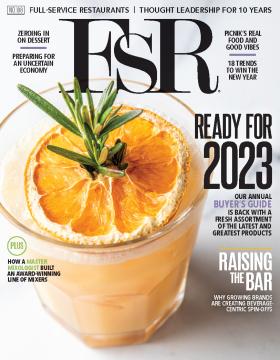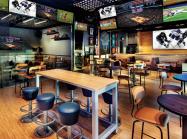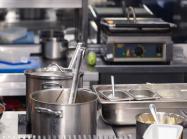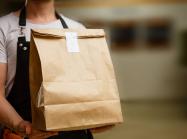Operators must be transparent with customers.
Ghost kitchens, delivery-focused kitchens without a storefront or dining area, are a growing trend, and with good reason. As customer demand has shifted due to the pandemic—and more consumers are looking for takeout or delivery options instead of onsite dining—food businesses have had to adjust accordingly. A decline in onsite dining demand, combined with supply chain disruptions, rising prices, and labor shortages, has made it challenging for many operators to continue running traditional restaurants. Additionally, traditional restaurants simply aren’t equipped to handle a surge in “to go” meals and paying the overhead for front of the house space (and staff) doesn’t always make sense anymore.
As 60 percent of American consumers order takeout or delivery at least once a week, and online ordering is growing 300 percent faster than in-house dining, many operators have rethought their business models, pivoting to ghost kitchens instead. Ghost kitchens are the perfect solution to prep and cook “to go” orders. And the popularity of ghost kitchens, currently a $43 billion industry, is skyrocketing, as experts predict that number will rise to $71.4 billion by 2027, and could be as high as $1 trillion by 2030.
It’s important to note that ghost kitchens—like traditional restaurants—need to prioritize food safety and quality assurance.
Ghost kitchen operators and employees should be sure to:
Prioritize food safety. Never stop focusing on food safety protocols, like cooking to proper temps, storing foods properly, not cross-contaminating, accommodating food allergies, etc. Use thermometers to check that foods have been cooked to proper temperatures. Install digital sensors to alert the team if a refrigerator or freezer door is accidentally left open, or if temperatures drop below a certain level. Designate a prep space for allergy-friendly meals, and don’t use common allergens (e.g., peanuts, tree nuts) in this area.
Follow COVID protocols consistently. In addition to following food safety protocols, your team must adhere to COVID protocols: frequent sanitation of high-touch areas, frequent hand washing, social distancing, and masking. Don’t allow employees to work when ill. Stay up to date on the latest guidance from the CDC and communicate any new information to staff.
Be transparent. Consumers have become more concerned about whether restaurants (and ghost kitchens!) are taking proper safety precautions. They want reassurance that your staff is washing their hands, sanitizing surfaces, wearing masks during meal prep, and not working when ill. They also want to know that you’re following all food safety and quality protocols to keep your foods (and your customers) safe and healthy. Promote your safe practices on social media to boost trust during these exceptional times.
Create a culture of collaboration and development. COVID changed many aspects of restaurant operations, including disrupting traditional, onsite, third-party audits. Therefore, food businesses have adjusted the way they audit, using a combination of self-assessments, remote and onsite audits to ensure compliance and minimize risks. Audits have also evolved from punitive to collaborative, where the kitchen team is involved and invested. This helps build a culture of excellence and safety and makes everyone feel responsible for food safety success.
Train constantly. Training shouldn’t be a “one and done” endeavor. Instead, make it standard protocol to train each employee when they’re hired and throughout their tenure. Make sure employees know why the safety rules are in place (and why they’re so important), and they’ll be more likely to comply. Use tech tools to provide regular training, reminders, and small “bites” of information directly to employees’ smartphones.
Utilize digital tools. Tech tools help maximize food safety and minimize risks. Use digital tools to access information, analyze data, and spot trends. Tech solutions can streamline food safety checklists, elevate audits and self-assessments, and help employees better manage food safety processes.
Monitor vendors’ food safety policies. Only work with vendors and suppliers that adhere to the strictest safety and quality standards. Today’s software solutions allow operators to manage supplier certifications efficiently and accurately, with information easily accessible in one central location.
Ensure safe foods from your kitchen to customers’ homes or offices. Food safety doesn’t stop when the meals leave your kitchen. Work with drivers (and delivery services) that are committed to food safety. They must have equipment to keep foods at proper temperatures—hot foods hot, cold foods cold. Drivers should also sanitize their hands frequently, including after they touch doorknobs, doorbells, money, pens, etc. Additionally, drivers should wear masks when interacting with customers.
We’ve all grown pandemic-weary at this point, as COVID has ravaged our industry for nearly two years now. But we’re seeing some positive developments arise from the coronavirus chaos, like the increase in ghost kitchens and new ways to meet customer demand. Ghost kitchens are an exciting new trend that enable food operators to serve delicious (and safe!) food while significantly reducing their overhead costs during this exceptional time.
Dallas Henderson, a 25-year veteran of the service industry, is an Account Manager at RizePoint. RizePoint is disrupting traditional market software with their innovative, new product platform Ignite™ Supplier Certification Management, which helps small to medium sized businesses simplify the supplier certification and maintenance process. To discuss RizePoint’s solutions, please contact Dallas at dallas.henderson@rizepoint.com.




%20(1)_099fe.png)











